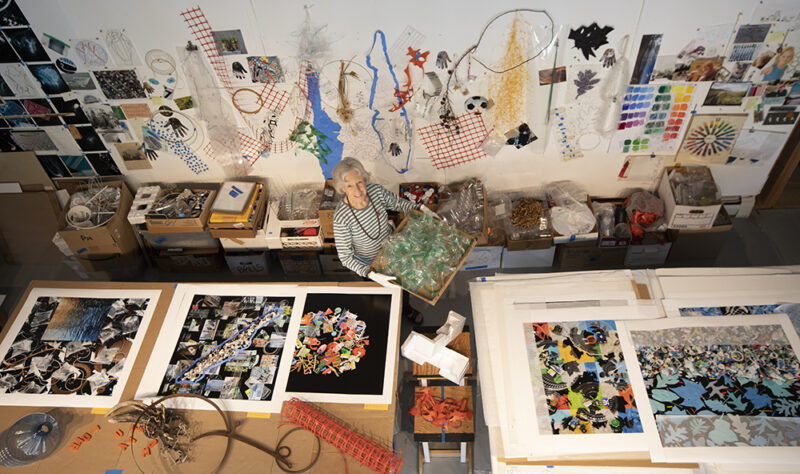
Confronting the rising tide of plastic waste, Susan Hockaday and her family fill the world with music, art, design, adventure, and good chemistry
By Ilene Dube | Photography by Andrew Wilkinson
Several years ago, artist Susan Hockaday was invited by First Lady Tammy Murphy to exhibit her fine art photographs of plastic detritus at Drumthwacket, the official residence of the governor of New Jersey. Hockaday has photographed the non-biodegradable remains of our civilization from all vantage points: flying overhead with a pilot friend; weaving in and out of old ship skeletons in a boat graveyard in Arthur Kill, the tidal strait between Staten Island and New Jersey (“I never had more fun, it was like being 16 years old,” she said); under water at Cape Breton Island; and on tabletop tableaus in her studio.
“Soft petaled flowers, weathered branches, polished stones, and shells blend with man-made objects,” Murphy wrote in the accompanying exhibition catalog. “Yet, upon closer inspection, a menacing struggle disrupts the ostensibly harmonious scene. Plastic containers, twisted bits of rope, and nets slowly entwine and strangle their organic counterparts.”
 Why is the artist obsessed with plastic waste?
Why is the artist obsessed with plastic waste?
“Plastic has now bonded with biology,” Hockaday writes on her website, referring to the Great Garbage Patches of plastics in our oceans. “Plastic has become my symbol of climate change, of a planet being overwhelmed by millions of destructive changes in the rhythms of nature.” Whether working in drawing, etching, photograms, papermaking, or photography, she has, over the decades, focused on the unruliness in nature.
While putting together the show for the Princeton-based Drumthwacket Foundation, Hockaday welcomed the curator on a studio visit to her Hopewell home, a refurbished barn that — in contrast to unruly nature — is elegantly appointed with a George Nakashima dining table, Hans Wegner chairs, Eero Saarinen chaise, Charles Webb sofa, and George Nelson lamps. As the two were chatting, Hockaday observed a snake clinging to the stone fireplace surround.
Ever resourceful, she donned a pair of rubber gloves, seized the reptile, heaved it outside into the woods, and shut the door. “Barns are notoriously permeable,” Hockaday calmly stated during a recent interview. “Animals are continuously trying to get back inside and sometimes succeed. I took off the gloves, and we never talked about it. She was a really nice person. We felt a teeny bit embarrassed.”
The story illustrates both the artist’s embrace of the natural world, its unruliness, and her fortitude in dealing with its intrusions. more




 Why is the artist obsessed with plastic waste?
Why is the artist obsessed with plastic waste? 
















